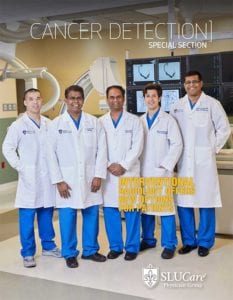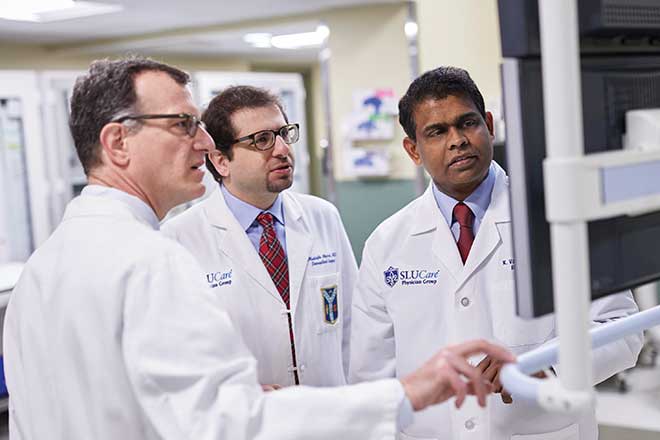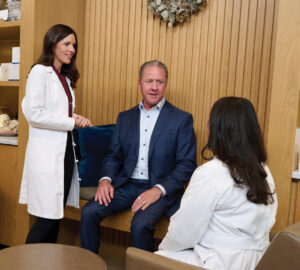Whenever a diagnosis of liver cancer is made, tough questions arise for the patient: What does this mean for my health? What are my treatment options? What will my future hold? With the number of U.S. cases more than tripling since 1980, according to the American Cancer Society, it’s an area of increasing scrutiny for doctors and researchers.
No two cases of the disease are exactly alike, so the best treatment depends on informed medical opinions. That’s what liver cancer patients can expect when they arrive at SLUCare for consultation and treatment, doctors there say. “Our goal is comprehensive care for each person,” explains Dr. Mustafa Nazzal, a SLUCare physician and assistant professor of surgery at Saint Louis University School of Medicine. “We have a multidisciplinary team of specialists who look at each case from a different angle. They combine their observations to give a better picture of what’s going on with each patient.”
Dr. Alex Befeler, SLUCare’s medical director of liver transplantation, says he serves as a ‘point person’ for his patients, guiding each care plan and ensuring all treatment details are in place. Nazzal consults with patients who may need tumor removal or transplant surgery, while Dr. Kirubahara Vaheesan, SLUCare interventional radiologist, helps explain treatments that can reduce tumor size and prepare a patient for a liver transplant if needed. Many of their patients come from outside St. Louis, so the care team can schedule multiple consultations on the same day to save patients time and stress as they prepare for treatment at SSM Health Saint Louis University Hospital.
 Befeler says generally there are two things going on with each liver cancer patient. First is a pre-existing chronic condition such as fatty liver disease, alcoholic liver disease or hepatitis, all of which can cause cirrhosis or scarring and lead to organ failure. Second is the cancer itself, most commonly hepatocellular carcinoma. Vaheesan says 10 to 15 percent of liver cancer patients can benefit from tumor removal surgery, and another 10 to 15 percent are full liver transplant candidates. The remaining patients may do well with minimally invasive treatments that help reduce their tumors.
Befeler says generally there are two things going on with each liver cancer patient. First is a pre-existing chronic condition such as fatty liver disease, alcoholic liver disease or hepatitis, all of which can cause cirrhosis or scarring and lead to organ failure. Second is the cancer itself, most commonly hepatocellular carcinoma. Vaheesan says 10 to 15 percent of liver cancer patients can benefit from tumor removal surgery, and another 10 to 15 percent are full liver transplant candidates. The remaining patients may do well with minimally invasive treatments that help reduce their tumors.
Doctors also may use these treatments to shrink a patient’s tumors before they are removed or a full transplant is done, according to Nazzal. “It’s called ‘downstaging,’” he explains. “Say, for example, that the patient has a tumor measuring 7 centimeters. The interventional radiologist needs to treat it and reduce it below 5 centimeters before a transplant can be performed.” Reducing the tumor makes the growth or the liver itself more resectable, or easier to remove, during surgery.
A patient can be eligible for a transplant if he or she has up to three cancerous liver lesions under 3 centimeters in size, or one lesion under 5 centimeters. “If the number is more than three or the size is beyond the criteria, the patient would undergo treatments to reduce the number or size,” Vaheesan notes. This can be done with procedures that use heat, targeted chemotherapy, targeted radiation or a combination of these techniques to attack tumors. “These are outpatient treatments, but 5 to 10 percent of patients still may need a day of hospital observation,” Vaheesan says.
He adds that the procedures have changed the way doctors treat patients by targeting cancer-killing agents directly at a tumor and avoiding damage to surrounding tissue. “The treatments tend to be well tolerated, and there are few side effects,” he notes. The radiation treatment, for example, is delivered by a microcatheter through an artery in the groin or wrist. Using a wrist artery is a new technique, and SLUCare is one of only a handful of providers performing it, Vaheesan says. The wrist site is more accessible and more comfortable than using a groin artery, and the patient can walk around after the procedure. These ‘pre-treatments’ are an important tool because studies have shown higher survival rates among patients who receive them, he says.
Befeler explains that the full timeline for liver transplantation usually takes most of a year, but that’s in the patient’s best interests. “Evaluation to decide if the person is a candidate can last a few weeks to a couple of months,” he notes. “We have to make sure the procedure will be well tolerated. If the person is a candidate, he or she is added to the transplant list, which has a six-month waiting period. After that, a donated organ may become available within another three months.”
Befeler adds, “Transplantation is considered curative and gives the best long-term chance for survival. And we have a good organ bank here in the Midwest. The availability of donated organs is better here than it is on either coast.”
Nazzal says today’s treatments and surgeries offer a good deal of hope for liver cancer patients. “The survival rate after liver transplant is very good,” he notes. “By taking out the whole organ, we are removing the cancer’s ‘factory’ so it can’t develop elsewhere. And the chances of the new liver developing the disease are relatively low.”
At the same time, liver cancer research is making important strides in the areas of new drugs and immunotherapy, which stimulates the body’s own immune system to fight cancer, Befeler notes. These developments will create important new options, he says, especially for patients with advanced cancers.
Pictured on the section cover: SLUCare interventional radiology team members Drs. Adam Fang, Kirubahara Vaheesan, Sameer Gadani, Mauricio Morel and Keith Pereira
SLUCare Physician Group and Saint Louis University Cancer Center provide a team approach and specialized care for patients with liver and other cancers. For more information, call 314.977.4440 or visit slucare.edu.
Cover design by Julie Streiler | Cover photo by SLUCare Physician Group








